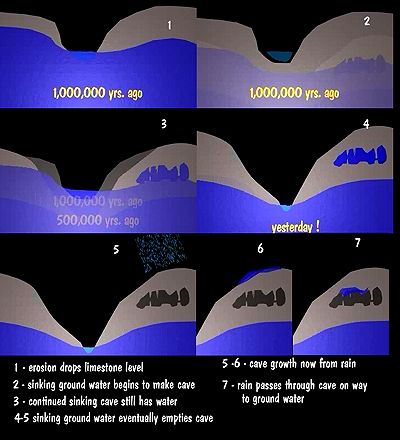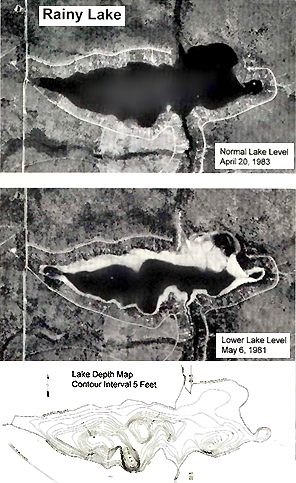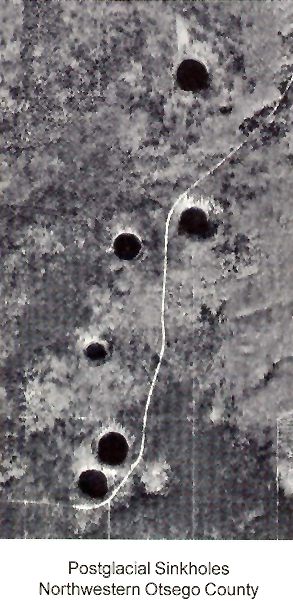Limestone, Dolostone and Marble are the chief sedimentary rocks made from carbonates. These are the rocks most likely to be weather by ground water.
Limestone (CaCO3), Dolostone ( (Mg, Ca)CO3), and Marble (CaCO3) are not very soluble in pure water, but react vigorously with carbonic acid. (CO2 in water.)
Loss rates up to 10 cm / 1000 yr. have been found in nature. (Doesn't sound like much, but 10 cm = 4 inches), and in a million years, that 1000 x 1000 yrs. That is 4000 inches, or about 330 ft. of loss.
Carbonate Cave formation
As the exterior landscape is weathered away, the average water table is lowered accordingly.
If the landscape is made up of "Limestone" in a given area (there are millions of square kilometers of limestone near the Earth's surface), then much of it is constantly dissolving.
When the water table falls it sometimes leaves behind caverns in the limestone. They continue to "live" for a while as the water table declines, as they are refreshed from the run-off from above. They end up in the newly derived "aeration zone". The water travels in a limestone deposit by winding its way through cracks and crevasses in the rock so it is not equally saturated like a sand based aeration zone.
The water that arrives within the cavern slowly drops fro the ceiling to the floor and begins the process of creating stalactites and stalagmites, and curtains of rock as well as travertine lined cave streams and other natural wonders.

(t = top)

(g = ground)
In areas where limestone makes up much of the rock base, sink holes are not uncommon. They are typically caves with roofs that have collapsed.
Michigan has numerous sinkholes through out much of the lower peninsula. Florida probably leads the country in sinkholes with more than a hundred new ones each year for the past several years.
They often appear suddenly, swallowing up cars, or even buildings when they show themselves. They are usually circular in shape and my drop anywhere from 10's of feet to over a hundred feet all at once.
 Photo Credit: Source
Photo Credit: Source
This source contians many more photos and more extensive information.

Sink holes sometimes appear in closely spaced groups and may after their initial formation seal themselves again by washed in silt.
When they do they become ponds or even lakes. The danger of such a pond or lake, is that the sealed bottom may also give way and once again open to fast removal of the water ... sort of like pulling the stopper out of a sink.
There are recorded cases where an entire lake drained in a matter of minutes.
| NEXT | TOC | PREV |